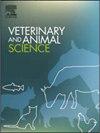Post-vaccination evaluation of an erysipelas/parvovirus bivalent vaccine administered to sows during lactation on follicular development and piglet growth
IF 1.9
Q2 AGRICULTURE, DAIRY & ANIMAL SCIENCE
引用次数: 0
Abstract
Vaccines against Erysipelothrix rhusiopathiae (ER) and porcine parvovirus (PPV) are employed in sow farms worldwide. This study evaluated the impact of administering a bivalent ER/PPV vaccine during lactation. Multiparous sows (n = 83) of two different farms (A (herd size 900 sows) and B (1000 sows)) were allocated in two different groups: 1) sows inoculated with saline solution (non-vaccinated group); 2) sows inoculated with the bivalent vaccine against ER/PPV (vaccinated group). The injections were administered at ∼11 days of lactation. The study was conducted in four different experiments: the first experiment, evaluating the female genital tract (uterus and ovary) and follicle development, was performed in culled sows (n = 19) of Farm A the day after weaning (∼24 days). The remaining experiments, which examined internal temperature, offspring growth, and sow feed intake, were conducted at Farm B (n = 64). The results of follicle populations, showed a greater frequency of large follicles in non-vaccinated compared to vaccinated sows was observed (p < 0.001). The final weight of the piglets and their weight gain were higher in the non-vaccinated group (p ≤ 0.05). A statistical trend was also observed in the average weight gain of piglets. No differences were observed regarding sow´s rectal temperature between groups around the period of injection but the vaccinated group consumed less sow feed on the day of injection (p = 0.016). In conclusion, the administration of this vaccine against ER/PPV during the lactation period had a negative impact on follicle development, sow feed intake, and offspring weight gain and final weight.
乳母接种丹毒/细小病毒二价疫苗后对卵泡发育和仔猪生长的影响
世界各地的母猪养殖场都采用了抗红喉丹毒(ER)和猪细小病毒(PPV)的疫苗。本研究评估了在哺乳期接种双价ER/PPV疫苗的影响。选取两个不同猪场(A场900头,B场1000头)的产母猪83头,分为两组:1)接种生理盐水组(未接种组);2)接种ER/PPV双价疫苗的母猪(接种组)。在哺乳期第11天注射。该研究分为四个不同的实验:第一个实验是在A农场宰杀的母猪(n = 19)断奶后第一天(~ 24天)进行的,评估雌性生殖道(子宫和卵巢)和卵泡发育。其余试验在B农场(n = 64)进行,检测内部温度、子代生长和母猪采食量。卵泡群体的结果显示,与接种疫苗的母猪相比,未接种疫苗的母猪出现大卵泡的频率更高(p <;0.001)。未接种组仔猪终末体重和增重显著高于对照组(p≤0.05)。仔猪的平均增重也有统计学趋势。注射前后各组母猪直肠温度差异无统计学意义(p = 0.016),但注射当日接种组母猪饲料消耗较少。综上所述,在哺乳期接种ER/PPV疫苗对卵泡发育、母猪采食量、子代增重和最终体重均有负面影响。
本文章由计算机程序翻译,如有差异,请以英文原文为准。
求助全文
约1分钟内获得全文
求助全文
来源期刊

Veterinary and Animal Science
Veterinary-Veterinary (all)
CiteScore
3.50
自引率
0.00%
发文量
43
审稿时长
47 days
 求助内容:
求助内容: 应助结果提醒方式:
应助结果提醒方式:


